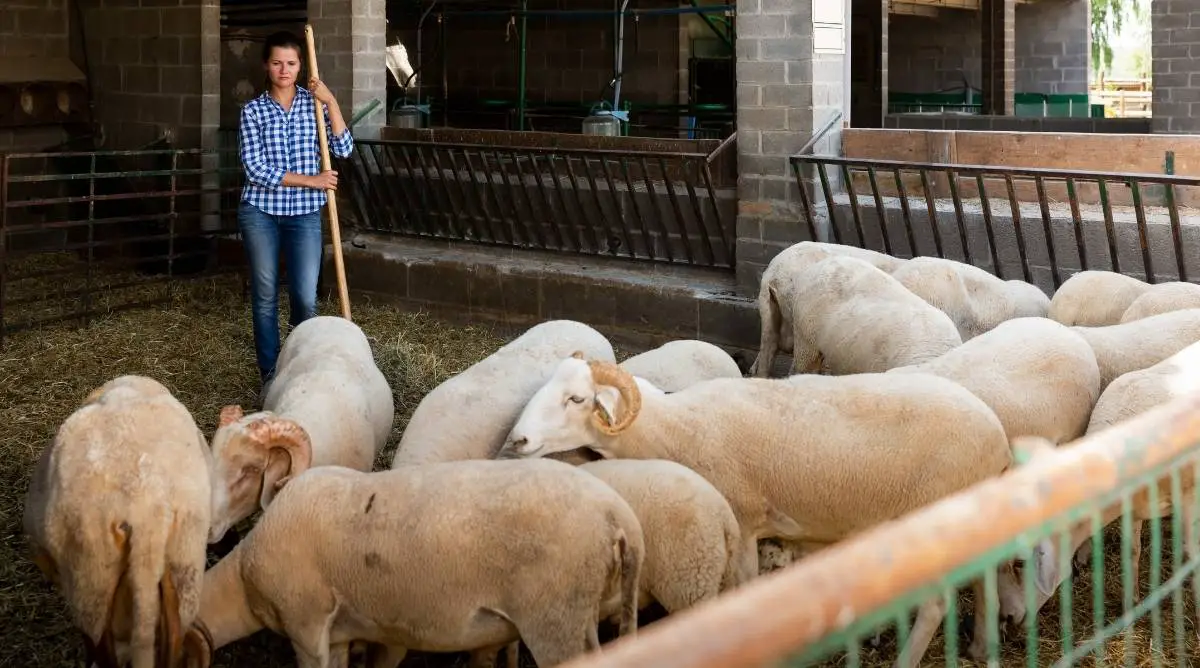For sheep farming beginners, it's essential to understand shelter, fencing, pasture land, fodder supply and feeders, water filtration system, troughs, and sheep care equipment. It's also critical to plan how your sheep farm will profit and whether you'll focus on selling lambs, meat, wool, or milk.
Table of Contents
Starting a sheep farm
One of the first things to figure out when starting a sheep farm is how much barn space you’ll need. Typically, it’s about 15 square feet per adult sheep.
Sheep are social animals that thrive in a group, so you should always keep multiple sheep together. On a small farm, start with at least two or three sheep. Provide the animals with at least a quarter of an acre of land. An acre of pasture is enough for a small flock (five to six sheep).
You can raise sheep on a farm or in your backyard, as long as the climate is moderate and you can arrange a shelter, adequate fencing, and enough grazing space for the animals.
Costs involved in sheep farming
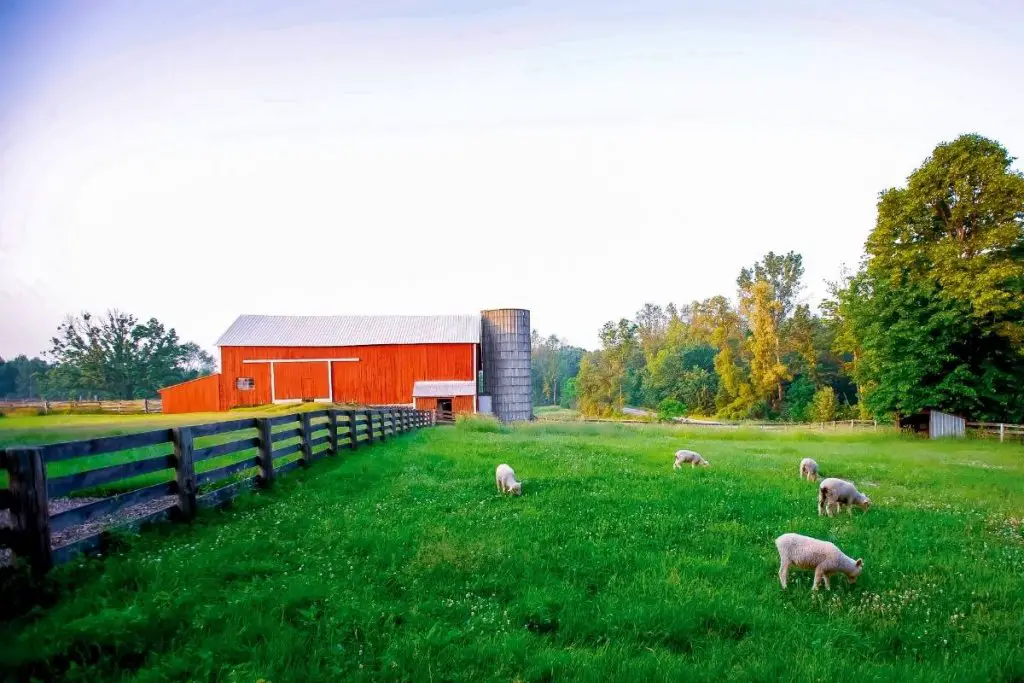
When evaluating sheep farm expenses and creating a business plan, factor in cost factors such as:
- Livestock prices (depends on the preferred breed of sheep, the animals’ genders, ages, and sizes)
- Farm infrastructure (fencing, troughs, sheep chutes)
- Health supplies (dewormers, hoof trimming tools, lambing kits)
- Winter/all-season necessities (hay, proteins, minerals)
- Education and marketing
Building a farm and buying sheep are the two biggest expenses you’ll have when starting out.
Depending on your knowledge and previous farming experience, spending on educational materials is optional.
Marketing largely depends on how you plan to profit from your farm. For instance, you can promote your sheep farming business via websites, magazines, newspapers, social media, or at fairs and shows.
Setting up your sheep farm
Sheep farm basics include:
- Shelter
- Fencing
- Pasture land
- Fodder supply and feeders
- Water filtration system and troughs
- Sheep care equipment
- Livestock guardians
Shelter
Sheep housing options include barns, sheds, and pole and metal buildings.
Hoop houses are a cheaper alternative. A hoop house is a hoop-shaped, greenhouse-type structure made of a metal frame and heavy fabrics.
If lambing season coincides with harsh weather conditions, you’ll need more complex facilities than if it occurs during mild weather periods. The shelter needs to be enclosed to protect sheep from bad weather. Good ventilation is a must to avoid respiratory issues in sheep.
Sheep shelters are not heated during winter, so you’ll also need bedding made of straw. Other materials you can use are:
- Hay
- Peanut, cottonseed, and oat hulls
- Corncobs
- Dried corn stalks
- Wood shavings and chips
- Sawdust
- Hemp
- Peat
- Leaves
- Sand
Fencing
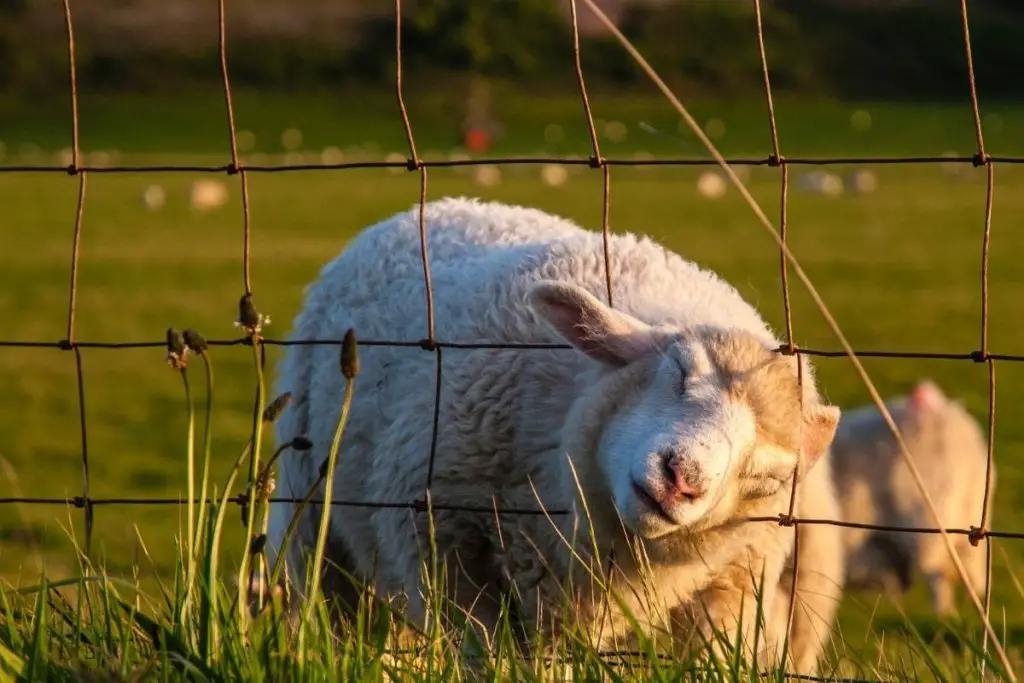
Fencing will be one of your biggest expenses. Compared to other farm animals like goats, sheep are easy to fence in. Fences have a dual purpose—they keep sheep in and protect them from predators, such as coyotes and wolves. Sheep farms should have perimeter and interior fencing.
Some fencing types can use materials that already exist on a farm. Others can be temporary before you find a better solution.
There are many variations:
- Electric netting
- High tensile non-electric
- Barbed, woven, or mesh wire
- Polywire
- Polytape
- Stock panels
- Board
- Split-rail
- Vinyl
- Chain link
The main purpose of perimeter fencing is protection against predators. It should be built all around the farm or whole grazing area.
Interior fencing divides the smaller grazing areas within the farm. It’s also used to separate rams from ewes, preventing aggressive behaviors and unplanned breeding.
Pasture land
Sheep require high-quality pasture to graze on, as it provides most nutrients they need. Depending on the climate, warm or cool season grasses may thrive on your property. You’ll need fertile soil regardless, and you can conduct soil testing to find out what plants the grassland is best for. Keep in mind that good-quality sheep pastures include legumes and forbs, as well as grasses.
Soil sampling is just the beginning of proper pasture management. Other best practices are:
- Controlling the stock rate (the number of sheep and the size of grazeable forage ratio)
- Employing pasture grazing strategies (such as rotational, continuous, and multispecies grazing)
- Developing a manure management system (essential for soil stability and water retention)
- Establishing a weed control plan (herbicides, clipping weeds not eaten by sheep to prevent overgrowth)
Fodder supply and feeders
When there is no forage available, sheep eat feed and supplements (hay, grain, minerals, etcetera). These materials need to be properly stored and kept dry.
Sheep farmers buy hay bales in bulk and keep them in storage sheds, hay lofts, or covered outside. Minerals, grain, and salt can be packed in barrels, old freezers, or garbage cans. Silage and baleage can be covered with plastic bags.
If you own sheep, you’ll also need hay feeders. You can purchase them from various companies or make your own.
Water filtration system and troughs
Sheep need a constant supply of clean, fresh water. They consume up to five gallons daily, depending on the moisture content of available forages or feeds.
Since naturally occurring water contains contaminants and sheep manure can cause parasite infestations, a water filtration system is useful for parasite control as well. Sheep farmers use troughs and various containers to provide water to the animals. Keep in mind that they need to be frequently cleaned.
Sheep care equipment
For basic sheep care, you’ll need the following equipment:
- Dewormers
- Drenching guns
- Hoof trimming supplies
- Medicine cabinets
- Lambing kits
- Sheep shearing machines
Livestock guardians
Flock guardians are excellent predator repellents. The most popular guardians are sheep herding dogs.
The best dog breeds include:
- Border Collie
- Shetland Sheepdog
- Corgi
- Mastiff
- Anatolian Shepherd
- Australian Shepherd
- Australian Kelpie
- Australian Cattle Dog
- New Zealand Huntaway
How to buy your first sheep
When selecting your first sheep, think about what you want your sheep operation to be. Are you interested in meat production, wool production, or do you want to join the dairy industry? Do you want commercial sheep at all or would you prefer show sheep?
Since age, size, and breed determine how much sheep cost, ewe and ram lambs are cheaper than adult sheep.
Depending on your region, you may find lambs for $50-$75. Adult sheep are generally priced between $150-$250. Older ewes can be cheaper, but are less productive and may not be able to breed.
It’s best to purchase sheep locally from a trusted breeder. Wherever you decide to buy, always check the condition of the ram’s feet and sheath and the ewe’s udder. Neither gender should limp, look underweight, or have pale eyes and gums.
What is the best breed of sheep for beginners?
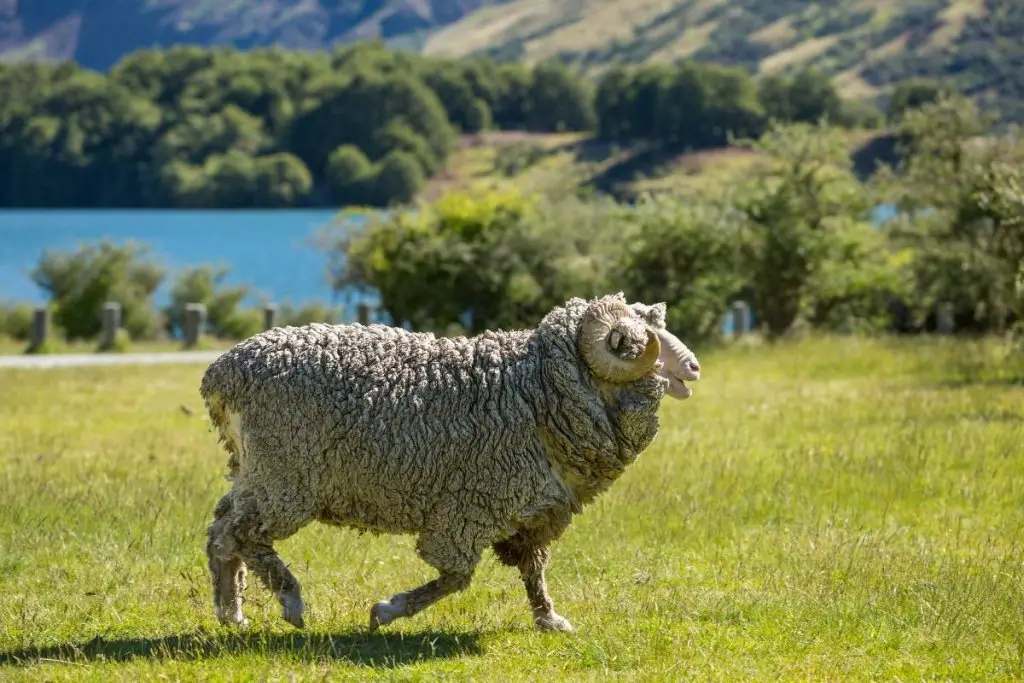
The best breed for you depends on your sheep farming business plan and preferences. Here are three beginner-friendly recommendations:
- Merino sheep produce the finest wool and are an excellent choice if you want show sheep. They’re small to medium-sized, highly adaptable, and can be kept on a small farm.
- Dorper sheep are known for being resilient and thriving in harsh climates and various grazing conditions. They’re also characterized by a high fertility rate, high lamb survivability, and great mothering instincts. This breed is a good option for beginners since it doesn’t need to be sheared.
- Katahdin sheep also don’t require shearing. They’re a low-maintenance meat sheep breed. Plus, they tend to be cheaper than other breeds, making them a go-to small-scale beginner choice.
Basics of raising sheep
Some sheep breeds are low-maintenance, while others require more care. Here are some common activities you’ll engage in while running a sheep farm.
What to feed your sheep
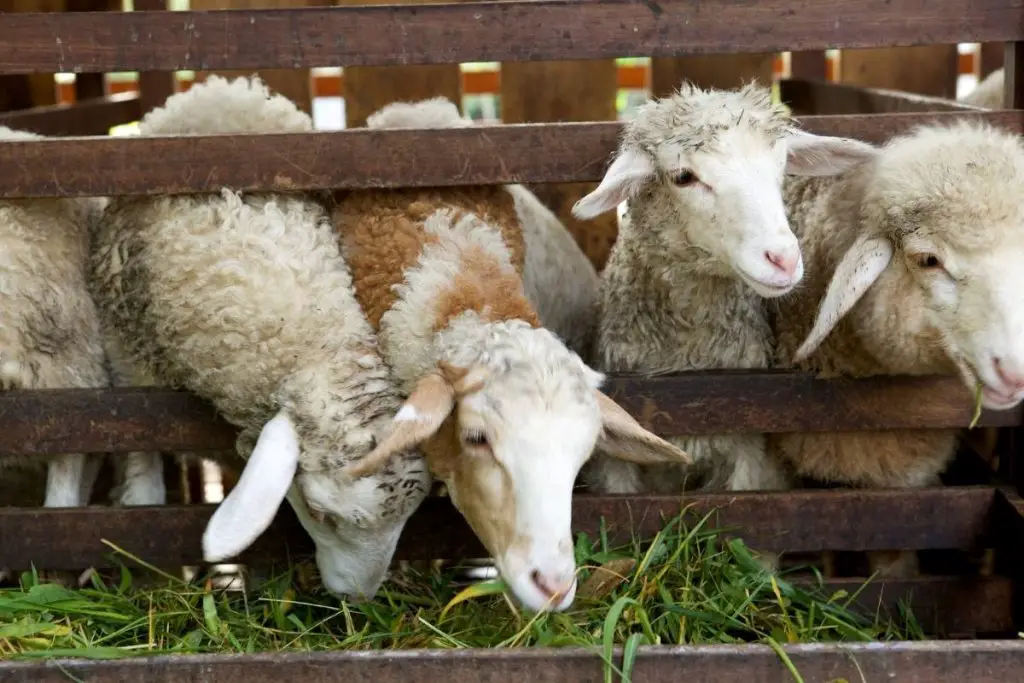
Sheep graze on grassland during the warm weather and need silage and hay during the winter. They need 2–3% of food per bodyweight per day. Sheep can eat:
- Native grasses
- Bermudagrass
- Forbs
- Tall fescue
- Vetch
- Red clover and many more plants
You can also feed them occasional treats, like:
- Apple slices
- Bananas
- Strawberries
- Watermelons
- Carrots
- Cucumbers
Never feed sheep citruses, cherries tomatoes, potatoes, celery, avocados, and chocolate. Those foods are poisonous to sheep.
Docking
Pros of docking sheeps’ tails include:
- Keeping them cleaner
- Blowfly strike prevention
- Providing easier access to the ewe’s udder and vulva to identify milking and birthing problems early
There are certain cons of docking:
- Increased risk of rectal prolapse
- It’s painful to the animals, and anesthetics are usually not utilized
- Certain markets favor undocked lambs
Docking is typically done in the lambs’ first weeks of life. To do it safely, follow one of the three standard docking techniques:
- Rubber ring (involves a rubber band application via an elastrator)
- Hot blade (a heated docking iron is used to cut off the tail)
- Rubber ring followed by crushing (a bloodless castrator is added after a rubber ring is applied, reducing the pain)
Ear tagging
Livestock is commonly ear tagged for easier identification.
Benefits of ear tagging sheep include:
- Rapid sorting by sex
- Age indication
- Sire/dam fast check
- Lamb type sorting (single, twins, or triplets)
- Ailment indication
Tagging is best done in lambs to prevent the risk of tag wound infection.
It’s a quick and easy process. Load a sheep ear tagger with a tag, align it, and disinfect the tool. Then simply position it on the sheep’s ear, squeeze to pierce, and you’re done.
Lambing
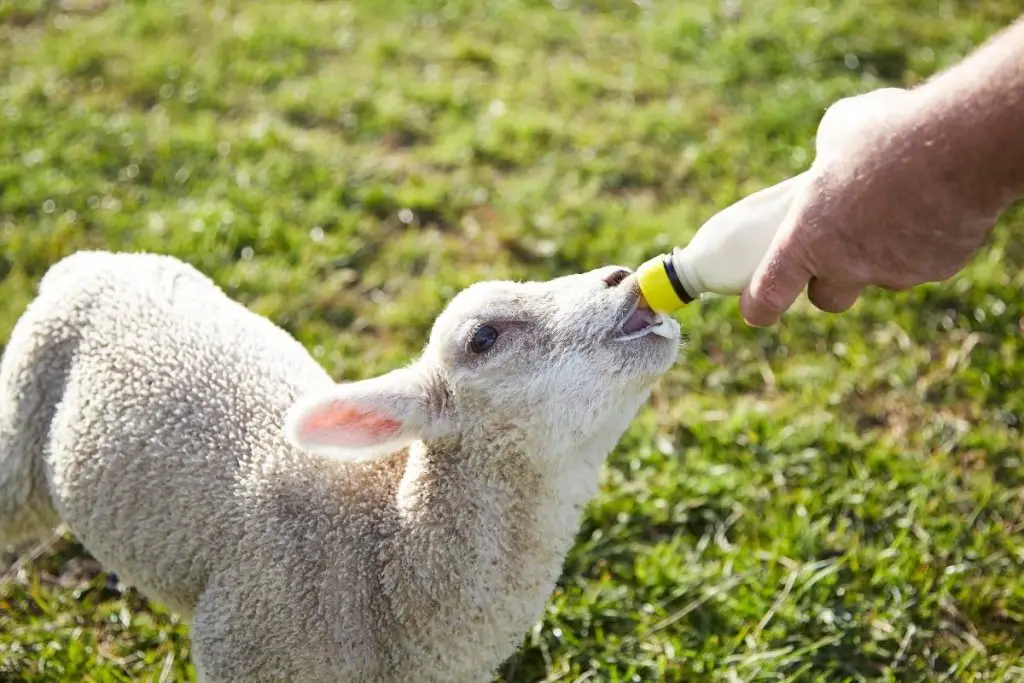
Lambing often happens without the need for human interference. However, sometimes difficult births occur and you either need to assist a ewe or call a veterinarian to help with the birth.
If the ewe strains for more than an hour, or if her vulva or udder is red and swollen, you may need to get involved.
Healthy ewes can take care of newborn lambs independently after birth. Moving each ewe and her lambs into separate lambing jugs is best.
All lambs need to consume colostrum from the first milk. Check lactating ewes’ udders for milk supply and mastitis. You may need to hand feed the lambs if there isn’t enough milk. A standard lambing kit that can help you includes lamb feeding bottles, feeding buckets, syringes, and more.
The nutrition of nursing ewes needs to be high in energy. Make sure to feed them high-quality hay (alfalfa hay, for instance) and a grain-protein supplement like a corn-soybean meal.
Shearing
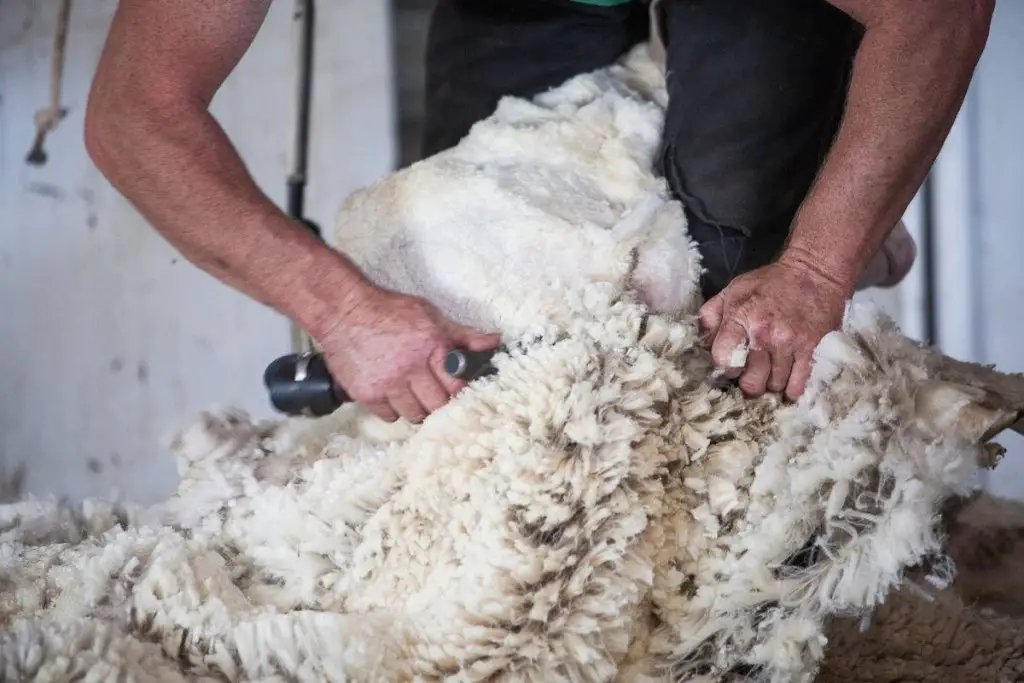
For beginners, it’s best to hire a professional shearer. You can do it yourself, but it’s not recommended to try with no experience.
Shearers without experience can take more time, and the animal may become agitated and stop cooperating. This can result in injury or damaged wool.
Here’s a step-by-step rundown of how to shear sheep:
- Plant the sheep on its rump, and then roll it onto its right hip.
- Using sharp-cutter electric sheep shears, begin shearing its left rear leg.
- Next, sit the sheep on its rump to shear its neck and head.
- Then, move it to its right side to access the side and back.
- The next position is on the right hip and neck bent across its left shoulder, between your legs. Sheer the neck and the right shoulder.
- Finally, place the sheep on its left hip. The animal’s head and legs are in front of you while it leans on your legs. Finish shearing the right leg, hip, and rump.
How to make money with a sheep farm
There are a number of ways to make money with sheep:
- Selling lambs
- Selling meat
- Selling wool
- Selling milk and dairy products
- Raising breeding stock
- Renting sheep out for pasture management
Breeding stock can be highly profitable. Commercial breed pedigree rams and ewes sell for great prices at auctions, for example.
Fine wool is always in demand. Moreover, Merino lambs sell for more than other breeds, so you may consider starting with those if your budget allows.
Sheep production takes time to become profitable. Make sure you have adequate savings before relying on sheep farming for a full-time income.
Benefits of sheep farming
Some advantages of sheep farming are:
- Fine-grade sheep wool and meat are in high demand
- Most sheep breeds are resilient and have excellent climate adaptability
- Sheep manure can be used for growing crops
- Sheep can eat various plants, virtually anything you have on your grassland
- Sheep operations can be large or small scale
Sheep farming can have the following disadvantages:
- The initial expenses may not be worth waiting for the returns
- Sheep farms have to be well-managed, even though most breeds are low-maintenance when compared to cattle
- Sheep are susceptible to many predators and need to be heavily protected
- Various lambing problems can occur, causing financial losses for the farmer
The easiest way to get started is by creating a viable business plan, purchasing a small flock, and expanding as you become more experienced.

